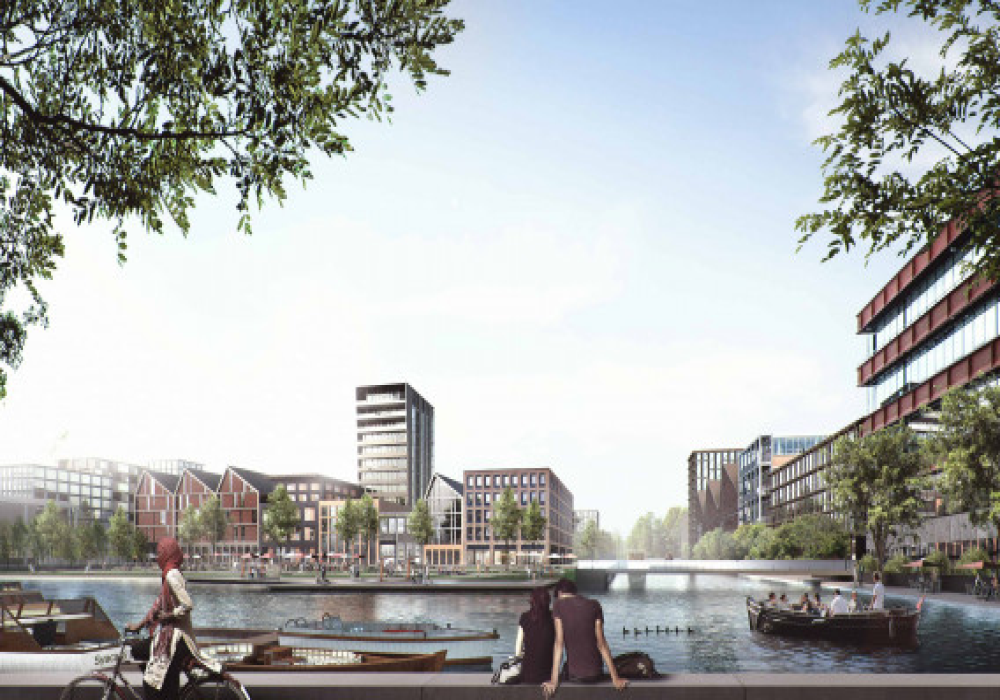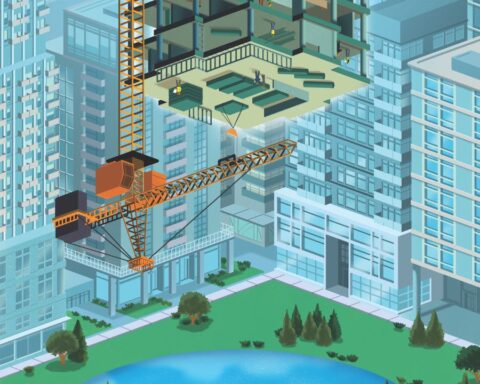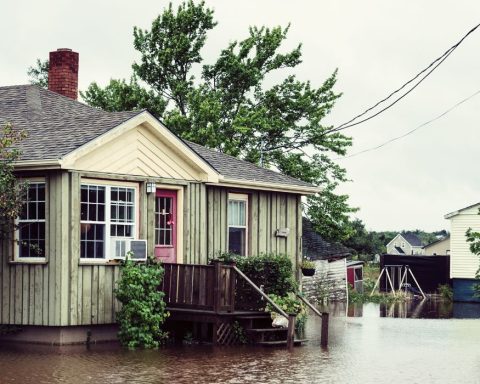It will be, without question, a generational game-changer.
When U.S. President Joe Biden signed the Inflation Reduction Act in August 2022, he set in motion a seeming avalanche of public and private investment in climate solutions, including those focused on the building sector, which accounts for about 40% of global greenhouse gas emissions. The bill will allocate US$391 billion toward climate solutions, including new tax credits for residential energy retrofits, energy efficiency rebates and a range of related measures, such as new energy efficiency standards for air conditioners and other HVAC equipment. There’s also funding for retrofits, updated building energy codes, and deductions for commercial buildings that reduce their energy consumption.
The Inflation Reduction Act’s impact extends across the 49th parallel, as Prime Minister Justin Trudeau’s Liberal government has sought to make sure that the unprecedented public funding in the U.S. doesn’t suck green investment out of Canada, including investment that will decarbonize buildings.
Herewith, a sampling of what 2023 may have to offer in the world of green buildings.
Green ‘proptech’
Private equity has increasingly sought out “proptech” ventures, and especially green proptech – technologies designed to improve the environmental performance of buildings. A/O PropTech, a venture capital firm specializing in this space, reported recently that this sector has clocked an 84% annual growth rate over the past five years, with US$4.5 billion allocated globally, much of it landing in European cities. A/O PropTech itself has a stake in 22 firms, including property-management software platforms, electrical-appliance control systems and various planning analytics tools.
According to a new market analysis entitled The Future of Building in a Low Carbon World, the company says it sees investment opportunities in the coming years in a range of construction-related verticals, such as green procurement software, architectural software that enables low-carbon design approaches, and emerging building materials. In particular, A/O predicts further innovation in the design of modular housing, citing the US$1.6 billion invested in the prefab (aka modular construction) industry in 2022, which was two-and-a-half-times more than the previous year.
The modular construction sector – which relies on factory-built components and assembly to drive up productivity and quality control – has generated a lot of attention recently as pressure to accelerate the development of affordable housing builds due to skyrocketing real estate prices and rents in many cities. Modular construction is also associated with cleaner construction as it can be done faster, and with reduced waste and emissions.
Carbon disclosure makes for green buildings
The push in recent years to build more energy efficient buildings can inadvertently boost the use of carbon-intensive construction materials, like certain types of insulation. Similarly, urban intensification, which reduces transportation-related carbon, also tends to drive up the use of carbon-intensive materials, like concrete, steel and glass.
Efforts to push developers to assess and disclose the embodied carbon in their projects, and then report on the energy performance of their buildings, have gained some traction in recent years, for example with New York City’s Local Law 97, which mandates asset managers to begin filing assessments of energy consumption by 2025. The Toronto Green Standard, updated in May 2022, now requires developers to measure and disclose embodied carbon if they want to qualify for certain rebates for green building projects. And Canada’s federal government in late 2022 established an embodied carbon standard for its own construction projects.
Interestingly, large asset managers are the ones pushing for more disclosure and better reporting. In an October 2022 report entitled Full Disclosure, the Canada Green Building Council, representing firms with $110 billion in assets, called on governments to establish building-energy disclosure guidelines and mandate data sharing as a prerequisite for approvals. “Data transparency and benchmarking can help guide energy and emissions reductions, and more broadly, can aid in the development of effective policies and programs,” the report said. All the members have vowed to make their own data – good, bad or ugly – public.
Circular construction
Data and disclosure aren’t the sole drivers. As cities move to intensify, there’s growing interest in recycling construction debris from older buildings as a means of reducing construction-related emissions. But as The New York Times reported in a widely read October 2022 feature, circular-economy-minded Dutch architects and builders increasingly look to “urban mining” as a means of sourcing cast-off materials – like discarded clothing refashioned into insulation – for new projects.
Amsterdam has gone one step further, by monitoring its circular economy performance and making the results public. The city’s first pass was self-critical. “Despite many initiatives, the bulk of Amsterdam’s economy is still based on intensive primary material consumption.” As the old saying goes, you can’t manage what you don’t measure.
Renewables paired with storage
The growth of solar is on a steep upward trajectory, driven by falling prices, expanding incentives and, in some jurisdictions, including Tokyo and parts of the EU, mandates on new construction. But with the proliferation of electric vehicles and thus demand for renewable electricity, combining solar panels with utility-scale storage is poised to see accelerated growth in the next several years. Indeed, the expanded role of solar and storage will enable more homes and commercial buildings to transition to electric heat.
The massive scaling up of renewables is a necessary step in the energy transition but not sufficient, given issues with intermittent supply. Local grids, feeling the pinch from increased electricity demand, need new deployments of both local renewables and storage systems that can store and then provide off-peak power. “By 2025, over 29% of all new behind-the-meter solar systems will be paired with storage, compared to under 11% in 2021,” according to the Solar Energy Industries Association. “The utility-scale market is also recognizing the benefits of pairing solar with storage, with over 45 [gigawatts] of commissioned or announced projects paired with storage, representing over 50 [gigawatt hours] of storage capacity.”
Storage initiatives come in many flavours – battery farms, pumped hydro (surplus power used to pump water into reservoirs), or the production of green hydrogen for fuel cells with industrial–scale electrolyzers. In its 2022 budget, Canada’s federal government introduced a 30% tax credit for companies developing battery storage and clean hydrogen solutions. The Biden administration in 2021 pumped US$9.5 billion into clean hydrogen development, with more expected under the Inflation Reduction Act. However, clean hydrogen for home energy is not yet a slam dunk. A much-hyped “world-first” project in Scotland, to use green hydrogen to replace natural gas, has succumbed to delays and technical problems.
Investor interest in offshore wind will also drive investment in storage and green hydrogen production. According to a 2022 year-end review by the U.S. Office of Energy Efficiency and Renewable Energy, the amount of offshore capacity in the development pipeline grew 13%, with more than 40,000 megawatts planned or under construction. The demand will be stoked by tax credits and grants enabled by the Inflation Reduction Act. The European Union and the United Kingdom have 100 gigawatts of offshore planned by 2030 – enough to power 75 million homes. Despite its extensive shoreline, Canada lags behind the U.S., with 5 GW of offshore wind to be built off the coast of Nova Scotia by 2030.
The surge of investment that will be unleashed this year by the Inflation Reduction Act comes at a fortuitous moment, as it dovetails with critical refinements in renewable energy systems, green building technology and consumer/developer attitudes about why decarbonizing the built environment is a critical piece of the fight to reverse the climate crisis. Perhaps 2023 will be the year when all the pieces begin to fit together.







